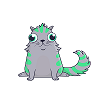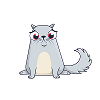Inside the CryptoKitties 256-Bit Genome - Slice & Dice Unique Bits & Bytes - 48 Genes (12 Traits x 4 P, H1, H2, H3)
At the heart of crypto collectibles on the blockchain are unique bits & bytes. For CryptoKitties this is a 256-bit integer that holds the super "sekretoooo" genome / genes.
Let's use Kitty #1001 as an example and look at the "magic" 256-bit integer number:
# A 256-bit super "sekretoooo" integer genome
# hexadecimal (base 16)
genome = 0x00004a52931ce4085c14bdce014a0318846a0c808c60294a6314a34a1295b9ce
# decimal (base 10)
genome = 512955438081049600613224346938352058409509756310147795204209859701881294
# binary (base 2)
genome = 0b010010100101001010010011000111001110010000001000010111000001010010111101110011100000000101001010000000110001100010000100\
011010100000110010000000100011000110000000101001010010100110001100010100101000110100101000010010100101011011100111001110Let's convert from decimal (base 10) to hexadecimal (base 16 - 2^4) and binary (base 2 that is, 0 and 1):
p genome # printed as decimal (base 10) by default
#=> 512955438081049600613224346938352058409509756310147795204209859701881294
p genome.to_s(16)
#=> "4a52931ce4085c14bdce014a0318846a0c808c60294a6314a34a1295b9ce"
p genome.to_s(2)
#=> "10010100101001010010011000111001110010000001000010111000001010010111101110011100000000101001010000000110001100010000100\
# 011010100000110010000000100011000110000000101001010010100110001100010100101000110100101000010010100101011011100111001110"So what? Thanks to Kai Turner
who first deciphered the CryptoKitties 256-bit genome
in The CryptoKitties Genome Project: On Dominance, Inheritance and Mutation on January 2018
we know today
that the genome breaks down into 5-bit chunks.
And every 5-bit chunk is a gene.
And four 5-bit chunks - known as the primary (p), hidden 1 (h1), hidden 2 (h2), and hidden 3 (h3) gene or
dominant (d), 1st recessive (r1), 2nd recessive (r2), and 3rd recessive (r3) -
get grouped into a trait
(e.g. fur, pattern, eye color, eye shape, base color, highlight color, and so on)
resulting in 12 trait groups of 4 (x 5-bit) genes
(that is, 12 x 4 x 5-bit = 240 bits) with the remaining leading 16 bits "unused" and zeroed-out (e.g. 0x0000).
Let's break the genome into 5-bit chunks
using Base32.encode from the base32-alphabets library.
require 'base32-alphabets'
Base32.format = :electrologica # use the Electrologica Alphabet / Variant
# hexadecimal (base 16)
genome = 0x00004a52931ce4085c14bdce014a0318846a0c808c60294a6314a34a1295b9ce # kitty 1001
p Base32.encode( genome )
#=> "09-09-09-09-06-07-07-04-01-01-14-01-09-15-14-14-00-05-05-00-06-06-04-04-13-08-06-08-01-03-03-00-05-05-05-06-06-05-05-03-09-08-09-09-11-14-14-14"Bingo! Using a genes / traits chart you can now decipher the genome.
Fur (0-3) • Pattern (4-7) • Eye Color (8-11) • Eye Shape (12-15) • Base Color (16-19) • Highlight Color (20-23) • Accent Color (24-27) • Wild (28-31) • Mouth (32-35) • Environment (36-39) • Secret Y Gene (40-43) • Purrstige (44-47)
Fur (FU) - Genes 0-3:
| Kai | Code | Name | Kai | Code | Name |
|---|---|---|---|---|---|
| 1 | FU00 | savannah | h | FU16 | norwegianforest I |
| 2 | FU01 | selkirk | i | FU17 | mekong I |
| 3 | FU02 | chantilly | j | FU18 | highlander I |
| 4 | FU03 | birman | k | FU19 | balinese I |
| 5 | FU04 | koladiviya | m | FU20 | lynx I |
| 6 | FU05 | bobtail | n | FU21 | mainecoon I |
| 7 | FU06 | manul | o | FU22 | laperm I |
| 8 | FU07 | pixiebob | p | FU23 | persian I |
| 9 | FU08 | siberian | q | FU24 | fox II |
| a | FU09 | cymric | r | FU25 | kurilian II |
| b | FU10 | chartreux | s | FU26 | toyger II |
| c | FU11 | himalayan | t | FU27 | manx II |
| d | FU12 | munchkin | u | FU28 | lykoi III |
| e | FU13 | sphynx | v | FU29 | burmilla III |
| f | FU14 | ragamuffin | w | FU30 | liger IIII |
| g | FU15 | ragdoll | x | FU31 | ? |
...
(Source: kittyverse/GENES.md)
Let's try Kitty #1001 as an example.
Let's start deciphering from right-to-left ...06-05-05-03-09-08-09-09-11-14-14-14, that is,
14 maps to ragamuffin, 14 to ragamuffin, 14 to ragamuffin, 11 to himalayan, and so on:
Fur (FU) - Genes 0-3:
| 5-Bit Chunk | Gene | Trait | |
|---|---|---|---|
| 14 | 0 | ragamuffin | Primary |
| 14 | 1 | ragamuffin | Hidden 1 |
| 14 | 2 | ragamuffin | Hidden 2 |
| 11 | 3 | himalayan | Hidden 3 |
Pattern (PA) - Genes 4-7:
| 5-Bit Chunk | Gene | Trait | |
|---|---|---|---|
| 09 | 4 | luckystripe | Primary |
| 09 | 5 | luckystripe | Hidden 1 |
| 08 | 6 | calicool | Hidden 2 |
| 09 | 7 | luckystripe | Hidden 3 |
Eye Color (EC) - Genes 8-11:
| 5-Bit Chunk | Gene | Trait | |
|---|---|---|---|
| 03 | 8 | mintgreen | Primary |
| 05 | 9 | sizzurp | Hidden 1 |
| 05 | 10 | sizzurp | Hidden 2 |
| 06 | 11 | chestnut | Hidden 3 |
and so on.
Let's try another kitty #1111:
genome = 0x000042d28390864842e7b9c900c6321086438c6098ca298c728867425cf6b1ac # kitty 1111
p Base32.encode( genome )
#=> "08-11-09-08-07-04-04-06-09-01-01-14-15-14-14-09-00-03-03-03-04-04-04-06-08-14-06-06-01-06-06-10-05-06-06-07-05-02-03-07-08-09-14-15-13-12-13-12"Again using a genes / traits chart you can now decipher the genome.
Let's start from right-to-left ...05-02-03-07-08-09-14-15-13-12-13-12, that is,
12 maps to munchkin, 13 to sphynx, and so on:
Fur (FU) - Genes 0-3:
| 5-Bit Chunk | Gene | Trait | |
|---|---|---|---|
| 12 | 0 | munchkin | Primary |
| 13 | 1 | sphynx | Hidden 1 |
| 12 | 2 | munchkin | Hidden 2 |
| 13 | 3 | sphynx | Hidden 3 |
Pattern (PA) - Genes 4-7:
| 5-Bit Chunk | Gene | Trait | |
|---|---|---|---|
| 15 | 4 | totesbasic | Primary |
| 14 | 5 | totesbasic | Hidden 1 |
| 09 | 6 | luckystripe | Hidden 2 |
| 08 | 7 | calicool | Hidden 3 |
Eye Color (EC) - Genes 8-11:
| 5-Bit Chunk | Gene | Trait | |
|---|---|---|---|
| 07 | 8 | strawberry | Primary |
| 03 | 9 | mintgreen | Hidden 1 |
| 02 | 10 | topaz | Hidden 2 |
| 05 | 11 | isotope | Hidden 3 |
and so on.
Encoding / decoding numbers in 5-bit chunks is called base 32
because 2^5 (=2 * 2 * 2 * 2 * 2) results in 32 values.
Using the Electrologica notation / alphabet
(00 01 02 03 04 05 06 07 08 09 10 11 12 13 14 15 16 17 18 19 20 21 22 23 24 25 26 27 28 29 30 31) the conversion chart reads:
| Base32 | Binary | Num | Base32 | Binary | Num | Base32 | Binary | Num | Base32 | Binary | Num |
|---|---|---|---|---|---|---|---|---|---|---|---|
| 00 | 00000 | 0 | 08 | 01000 | 8 | 16 | 10000 | 16 | 24 | 11000 | 24 |
| 01 | 00001 | 1 | 09 | 01001 | 9 | 17 | 10001 | 17 | 25 | 11001 | 25 |
| 02 | 00010 | 2 | 10 | 01010 | 10 | 18 | 10010 | 18 | 26 | 11010 | 26 |
| 03 | 00011 | 3 | 11 | 01011 | 11 | 19 | 10011 | 19 | 27 | 11011 | 27 |
| 04 | 00100 | 4 | 12 | 01100 | 12 | 20 | 10100 | 20 | 28 | 11100 | 28 |
| 05 | 00101 | 5 | 13 | 01101 | 13 | 21 | 10101 | 21 | 29 | 11101 | 29 |
| 06 | 00110 | 6 | 14 | 01110 | 14 | 22 | 10110 | 22 | 30 | 11110 | 30 |
| 07 | 00111 | 7 | 15 | 01111 | 15 | 23 | 10111 | 23 | 31 | 11111 | 31 |
The Kai (Base 32) notation / alphabet is named in honor of Kai Turner
who first deciphered the CryptoKitties 256-bit genome
in 5-bit chunks.
The Kai notation / alphabet
follows base56
and uses (123456789abcdefghijkmnopqrstuvwx).
The conversion chart reads:
| Kai | Binary | Num | Kai | Binary | Num | Kai | Binary | Num | Kai | Binary | Num |
|---|---|---|---|---|---|---|---|---|---|---|---|
| 1 | 00000 | 0 | 9 | 01000 | 8 | h | 10000 | 16 | q | 11000 | 24 |
| 2 | 00001 | 1 | a | 01001 | 9 | i | 10001 | 17 | r | 11001 | 25 |
| 3 | 00010 | 2 | b | 01010 | 10 | j | 10010 | 18 | s | 11010 | 26 |
| 4 | 00011 | 3 | c | 01011 | 11 | k | 10011 | 19 | t | 11011 | 27 |
| 5 | 00100 | 4 | d | 01100 | 12 | m | 10100 | 20 | u | 11100 | 28 |
| 6 | 00101 | 5 | e | 01101 | 13 | n | 10101 | 21 | v | 11101 | 29 |
| 7 | 00110 | 6 | f | 01110 | 14 | o | 10110 | 22 | w | 11110 | 30 |
| 8 | 00111 | 7 | g | 01111 | 15 | p | 10111 | 23 | x | 11111 | 31 |
Note: - the digit-0 and the letter-l are NOT used in the kai alphabet / notation.
Let's convert the example kitty genomes to Kai notation:
require 'base32-alphabets'
Base32.format = :kai # use the Kai Alphabet / Variant
# hexadecimal (base 16)
genome = 0x00004a52931ce4085c14bdce014a0318846a0c808c60294a6314a34a1295b9ce # kitty 1001
p Base32.encode( genome )
#=> "aaaa788522f2agff16617755e979244166677664a9aacfff"
genome = 0x000042d28390864842e7b9c900c6321086438c6098ca298c728867425cf6b1ac # kitty 1111
p Base32.encode( genome )
#=> "9ca98557a22fgffa144455579f77277b677863489afgeded"Tip: Use the Base32.fmt helper to pretty print / format
the encoded string into a group of four (genes). Example:
# hexadecimal (base 16)
genome = 0x00004a52931ce4085c14bdce014a0318846a0c808c60294a6314a34a1295b9ce # kitty 1001
p Base32.fmt( Base32.encode( genome ))
#=> "aaaa 7885 22f2 agff 1661 7755 e979 2441 6667 7664 a9aa cfff"
genome = 0x000042d28390864842e7b9c900c6321086438c6098ca298c728867425cf6b1ac # kitty 1111
p Base32.fmt( Base32.encode( genome ))
#=> "9ca9 8557 a22f gffa 1444 5557 9f77 277b 6778 6348 9afg eded"
p Base32.fmt( genome ) # or use the "all-in-one" shortcut
#=> "9ca9 8557 a22f gffa 1444 5557 9f77 277b 6778 6348 9afg eded"


